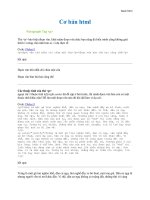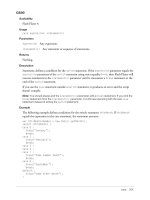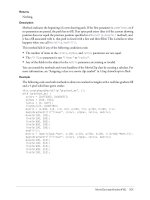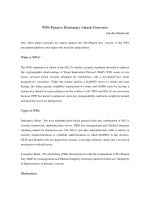Tài liệu Flash JavaScript Dictionary- P3 doc
Bạn đang xem bản rút gọn của tài liệu. Xem và tải ngay bản đầy đủ của tài liệu tại đây (353.12 KB, 100 trang )
Item object 201
Item object
Availability
Flash MX 2004.
Description
The Item object is an abstract base class. Anything in the library derives from Item. See also
library object.
Method summary for the Item object
The following methods are available for the Item object.
Property summary for the Item object
The following properties are available for the Item object.
Method Description
item.addData() Method; adds specified data to a library item.
item.getData() Method; retrieves the value of the specified data.
item.hasData() Method; determines whether the library item has the named data.
item.removeData() Method; removes persistent data from the library item.
Property Description
item.itemType Read-only; a string that specifies the type of element.
item.linkageClassName Property; a string that specifies the ActionScript 2.0 class that
will be associated with the symbol.
item.linkageExportForAS Property; a Boolean value. If true, the item is exported for
ActionScript.
item.linkageExportForRS Property; a Boolean value. If true, the item is exported for
runtime sharing.
item.linkageExportInFirstFrame Property; a Boolean value. If true, the item is exported in the first
frame.
item.linkageIdentifier Property; a string that specifies the name Flash will use to identify
the asset when linking to the destination SWF file.
item.linkageImportForRS Property; a Boolean value. If true, the item is imported for
runtime sharing.
item.linkageURL Property; a string that specifies the URL where the SWF file
containing the shared asset is located.
item.name Property; a string that specifies the name of the library item,
which includes the folder structure.
CHAPTER 3
Objects
202 Chapter 3: Objects
item.addData()
Availability
Flash MX 2004.
Usage
item.addData( name, type, data )
Parameters
name
A string that specifies the name of the data.
type A string that specifies the type of data. Valid types are "integer", "integerArray",
"double", "doubleArray", "string", and "byteArray".
data The data to add to the specified library item. The type of data depends on the value of the
type parameter. For example, if type is "
integer", the value of data must be an integer, and so on.
Returns
Nothing.
Description
Method; adds specified data to a library item.
Example
The following example adds data named myData with an integer value of 12 to the first item in
the library:
fl.getDocumentDOM().library.items[0].addData("myData", "integer", 12);
item.getData()
Availability
Flash MX 2004.
Usage
item.getData( name )
Parameters
name
A string that specifies the name of the data to retrieve.
Returns
The data specified by the name parameter. The type of data returned depends on the type of
stored data.
Description
Method; retrieves the value of the specified data.
Item object 203
Example
The following example gets the value of the data named myData from the first item in the library
and stores it in the variable
libData.
var libData = fl.getDocumentDOM().library.items[0].getData( "myData" );
item.hasData()
Availability
Flash MX 2004.
Usage
item.hasData( name )
Parameters
name
A string that specifies the name of the data to check for in the library item.
Returns
A Boolean value: true if the specified data exists; false otherwise.
Description
Method; determines whether the library item has the named data.
Example
The following example shows a message in the Output panel if the first item in the library
contains data point named myData:
if ( fl.getDocumentDOM().library.items[0].hasData( "myData" ) ){
fl.trace("Yep, it's there!");
}
item.itemType
Availability
Flash MX 2004.
Usage
item.itemType
Description
Read-only property; a string that specifies the type of element. Potential values are "undefined",
"component", "movie clip", "graphic", "button", "video", "folder", "font", "sound",
"bitmap", "compiled clip", and "video".
Example
The following example shows the type of the specified library item in the Output panel:
fl.trace(fl.getDocumentDOM().library.items[0].itemType);
204 Chapter 3: Objects
item.linkageClassName
Availability
Flash MX 2004.
Usage
item.linkageClassName
Description
Property; a string that specifies the ActionScript 2.0 class that will be associated with the symbol.
For this property to be defined, the
item.linkageExportForAS and/or
item.linkageExportForRS properties must be set to true, and the item.linkageImportForRS
property must be set to
false.
Example
The following example specifies that the ActionScript 2.0 class name associated with the first item
in the Library is myClass:
fl.getDocumentDOM().library.items[0].linkageClassName = "myClass";
item.linkageExportForAS
Availability
Flash MX 2004.
Usage
item.linkageExportForAS
Description
Property; a Boolean value. If true, the item is exported for ActionScript. You can also set the
item.linkageExportForRS and item.linkageExportInFirstFrame properties to true. The
item.linkageImportForRS property must be set to false if this property is set to true.
Example
The following example sets this property for the specified library item:
fl.getDocumentDOM().library.items[0].linkageExportForAS = true;
item.linkageExportForRS
Availability
Flash MX 2004.
Usage
item.linkageExportForRS
Item object 205
Description
Property; a Boolean value. If true, the item is exported for runtime sharing. This property can be
set to
true only if item.linkageImportForRS is set to false. Also, the properties
item.linkageIdentifier and item.linkageURL must be defined.
Example
The following example sets this property for the specified library item:
fl.getDocumentDOM().library.items[0].linkageExportForRS = true;
item.linkageExportInFirstFrame
Availability
Flash MX 2004.
Usage
item.linkageExportInFirstFrame
Description
Property; a Boolean value. If true, the item is exported in the first frame; if false, the item is
exported on the frame of the first instance. If the item does not appear on the Stage, it isn’t
exported.
This property can be set to
true only when item.linkageExportForAS and/or
item.linkageExportForRS are set to true.
Example
The following example specifies that the specified library item is exported in the first frame:
fl.getDocumentDOM().library.items[0].linkageExportInFirstFrame = true;
item.linkageIdentifier
Availability
Flash MX 2004.
Usage
item.linkageIdentifier
Description
Property; a string that specifies the name Flash will use to identify the asset when linking to the
destination SWF file. It must be specified if
item.linkageExportForAS and/or
item.linkageExportForRS are set to true.
Example
The following example specifies that the string my_mc will be used to identify the library item
when it is linked to the destination SWF file to which it is being exported:
fl.getDocumentDOM().library.items[0].linkageIdentifier = "my_mc";
206 Chapter 3: Objects
item.linkageImportForRS
Availability
Flash MX 2004.
Usage
item.linkageImportForRS
Description
Property; a Boolean value: if true, the item is imported for runtime sharing. If this property is set
to
true, both item.linkageExportForAS and item.linkageExportForRS must be set to
false. Also, you must specify an identif1ier (item.linkageIdentifier) and a URL
(
item.linkageURL).
Example
The following example sets this property to true for the specified library item:
fl.getDocumentDOM().library.items[0].linkageImportForRS = true;
item.linkageURL
Availability
Flash MX 2004.
Usage
item.linkageURL
Description
Property; a string that specifies the URL where the SWF file containing the shared asset is located.
Must be set when
item.linkageExportForRS or item.linkageImportForRS is set to true. You
can specify a web URL or a file name in platform-dependent format (that is, forward slashes (/) or
backward slashes (\), depending on the platform).
Example
The following example specifies a linkage URL for the specified library item:
fl.getDocumentDOM().library.items[0].linkageURL = "theShareSWF.swf";
item.name
Availability
Flash MX 2004.
Usage
item.name
Item object 207
Description
Method; a string that specifies the name of the library item, which includes the folder structure.
For example, if Symbol_1 is inside a folder called Folder_1, the
name property of Symbol_1 is
"Folder_1/Symbol_1".
Example
The following example shows the name of the specified library item in the Output panel:
fl.trace(fl.getDocumentDOM().library.items[0].name);
item.removeData()
Availability
Flash MX 2004.
Usage
item.removeData( name )
Parameters
name S
pecifies the name of the data to remove from the library item.
Returns
Nothing.
Description
Property; removes persistent data from the library item.
Example
The following example removes the data named myData from the first item in the library:
fl.getDocumentDOM().library.items[0].removeData( "myData" );
208 Chapter 3: Objects
Layer object
Availability
Flash MX 2004.
Description
The Layer object represents a layer in the Timeline. The timeline.layers property contains an
array of Layer objects, which can be accessed by
fl.getDocumentDOM().getTimeline().layers.
Property summary for the Layer object
The following properties are available for the Layer object:
layer.color
Availability
Flash MX 2004.
Usage
layer.color
Description
Property; a string that specifies the color assigned to outline the layer; equivalent to the Outline
color setting in the Layer Properties dialog box. Specified in hexadecimal #rrggbb format (where
r is red, g is green, and b is blue), a hexidecimal color value (such as 0xFF0000), or an integer
color value.
Property Description
layer.color Property; a string that specifies the color assigned to outline the layer.
layer.frameCount Read-only; an integer that specifies the number of frames in the layer.
layer.frames Read-only; an array of Frame objects.
layer.height Property; an integer that specifies the percentage layer height; equivalent to the
Layer height value in the Layer Properties dialog box.
layer.layerType Property; a string that specifies the current use of the layer; equivalent to the
Type setting in the Layer Properties dialog box.
layer.locked Property; a Boolean value that specifies the locked status of the layer.
layer.name Property; a string that specifies the name of the layer.
layer.outline Property; a Boolean value that specifies the status of outlines for all objects on
the layer.
layer.parentLayer Property; a Layer object that represents the layer’s containing folder, guiding, or
masking layer.
layer.visible Property; a Boolean value that specifies whether the layer’s objects on the
Stage are shown or hidden.
CHAPTER 3
Objects
Layer object 209
Example
The following example stores the value of the first layer in the colorValue variable:
var colorValue = fl.getDocumentDOM().getTimeline().layers[0].color;
The following example shows three ways to set the color of the first layer to red:
fl.getDocumentDOM().getTimeline().layers[0].color=16711680;
fl.getDocumentDOM().getTimeline().layers[0].color="#ff0000";
fl.getDocumentDOM().getTimeline().layers[0].color=0xFF0000;
layer.frameCount
Availability
Flash MX 2004.
Usage
layer.frameCount
Description
Read-only property; an integer that specifies the number of frames in the layer.
Example
The following example stores the number of frames in the first layer in the fcNum variable:
var fcNum = fl.getDocumentDOM().getTimeline().layers[0].frameCount;
layer.frames
Availability
Flash MX 2004.
Usage
layer.frames
Description
Read-only property; an array of Frame objects (see Frame object).
Example
The following example sets the variable frameArray to the array of Frame objects for the frames
in the current document:
var frameArray = fl.getDocumentDOM().getTimeline().layers[0].frames;
To determine if a frame is a keyframe, check whether the frame.startFrame property matches
the array index, as shown in the following example:
var frameArray = fl.getDocumentDOM().getTimeline().layers[0].frames;
var n = frameArray.length;
for (i=0; i<n; i++) {
if (i==frameArray[i].startFrame) {
alert("Keyframe at: " + i);
210 Chapter 3: Objects
}
}
layer.height
Availability
Flash MX 2004.
Usage
layer.height
Description
Property; an integer that specifies the percentage layer height; equivalent to the Layer height value
in the Layer Properties dialog box. Acceptable values represent percentages of the default height:
100, 200, or 300.
Example
The following example stores the percentage value of the first layer’s height setting:
var layerHeight = fl.getDocumentDOM().getTimeline().layers[0].height;
The following example sets the height of the first layer to 300 percent:
fl.getDocumentDOM().getTimeline().layers[0].height = 300;
layer.layerType
Availability
Flash MX 2004.
Usage
layer.layerType
Description
Property; a string that specifies the current use of the layer; equivalent to the Type setting in the
Layer Properties dialog box. Acceptable values are
"normal", "guide", "guided", "mask",
"masked", "folder".
Example
The following example sets the first layer in the Timeline to type “folder”:
fl.getDocumentDOM().getTimeline().layers[0].layerType = "folder";
layer.locked
Availability
Flash MX 2004.
Usage
layer.locked
Layer object 211
Description
Property; a Boolean value that specifies the locked status of the layer. If set to true, the layer is
locked. The default value is
false.
Example
The following example stores the Boolean value for the status of the first layer in the lockStatus
variable:
var lockStatus = fl.getDocumentDOM().getTimeline().layers[0].locked;
The following example sets the status of the first layer to unlocked:
fl.getDocumentDOM().getTimeline().layers[0].locked = false;
layer.name
Availability
Flash MX 2004.
Usage
layer.name
Description
Property; a string that specifies the name of the layer.
Example
The following example sets the name of the first layer in the current document to "foreground":
fl.getDocumentDOM().getTimeline().layers[0].name = "foreground";
layer.outline
Availability
Flash MX 2004.
Usage
layer.outline
Description
Property; a Boolean value that specifies the status of outlines for all objects on the layer. If set to
true, all objects on the layer appear only with outlines. If false, objects appear as they were
created.
Example
The following example makes all objects on the first layer appear only with outlines:
fl.getDocumentDOM().getTimeline().layers[0].outline = true;
212 Chapter 3: Objects
layer.parentLayer
Availability
Flash MX 2004.
Usage
layer.parentLayer
Description
Property; a Layer object that represents the layer’s containing folder, guiding, or masking layer.
Acceptable values for the parent layer are a folder, guide, or mask layer that precedes the layer, or
the
parentLayer of the preceding or following layer. Setting the layer’s parentLayer does not
move the layer’s position in the list; trying to set a layer’s
parentLayer to a layer that would
require moving it has no effect. Uses
null for a top-level layer.
Example
The following example uses two layers at the same level on the same Timeline. The first layer
(layers[0]) is converted into a folder and then set as the parent folder of the second layer
(layers[1]). This action moves the second layer inside the first layer.
var parLayer = fl.getDocumentDOM().getTimeline().layers[0];
parLayer.layerType = "folder";
fl.getDocumentDOM().getTimeline().layers[1].parentLayer = parLayer;
layer.visible
Availability
Flash MX 2004.
Usage
layer.visible
Description
Property; a Boolean value that specifies whether the layer’s objects on the Stage are shown or
hidden. If set to
true, all objects in the layer are visible; if false, they are hidden. The default
value is
true.
Example
The following example makes all objects in the first layer invisible:
fl.getDocumentDOM().getTimeline().layers[0].visible = false;
library object 213
library object
Availability
Flash MX 2004.
Description
The library object represents the Library panel. It is a property of the Document object (see
document.library) and can be accessed by fl.getDocumentDOM().library.
The library object contains an array of items of different types, including symbols, bitmaps,
sounds, and video.
Method summary for the library object
The following methods are available for the library object:
Method Description
library.addItemToDocument() Method; adds the current or specified item to the Stage at the
specified position.
library.addNewItem() Method; creates a new item of the specified type in the Library panel
and sets the new item to the currently selected item.
library.deleteItem() Method; deletes the current items or a specified item from the
Library panel.
library.duplicateItem() Method; makes a copy of the currently selected or specified item.
library.editItem() Method; opens the currently selected or specified item in Edit
mode.
library.expandFolder() Method; expands or collapses the currently selected or specified
folder in the library.
library.findItemIndex() Method; returns the library item’s index value (zero-based).
library.getItemProperty() Method; gets the property for the selected item.
library.getItemType() Method; gets the type of object currently selected or specified by a
library path.
library.getSelectedItems() Method; gets the array of all currently selected items in the library.
library.importEmbeddedSWF() Method; imports a Shockwave (SWF) file into the library as a
compiled clip.
library.itemExists() Method; checks to see if a specified item exists in the library.
library.moveToFolder() Method; moves the currently selected or specified library item to a
specified folder.
library.newFolder() Method; creates a new folder with the specified name, or a default
name (
"untitled folder #") if no folderName parameter is provided,
in the currently selected folder.
library.renameItem() Method; renames the currently selected library item in the Library
panel.
CHAPTER 3
Objects
214 Chapter 3: Objects
Property summary for the library object
The following property is available for the library object.
library.addItemToDocument()
Availability
Flash MX 2004.
Usage
library.addItemToDocument( position [, namePath] )
Parameters
position
A point that specifies the x,y position of the center of the item on the Stage.
namePath A string that specifies the name of the item. If the item is in a folder, you can specify
its name and path using slash notation. If
namePath is not specified, the current library selection
is used. This parameter is optional.
Returns
A Boolean value: true if the item is successfully added to the document; false otherwise.
Description
Method; adds the current or specified item to the Stage at the specified position.
Example
The following example adds the currently selected item to the Stage at the (3, 60) position:
fl.getDocumentDOM.library.addItemToDocument({x:3, y:60});
The following example adds the item Symbol1 located in folder1 of the library to the Stage at the
(550, 485) position:
fl.getDocumentDOM().library.addItemToDocument({x:550.0, y:485.0}, "folder1/
Symbol1");
library.selectAll() Method; selects or deselects all items in the library.
library.selectItem() Method; selects a specified library item.
library.selectNone() Method; deselects all the library items.
library.setItemProperty() Method; sets the property for all selected library items (ignoring
folders).
library.updateItem() Method; updates the specified item.
Property Description
library.items Property; an array of item objects in the library
Method Description
library object 215
library.addNewItem()
Availability
Flash MX 2004.
Usage
library.addNewItem( type [, namePath] )
Parameters
type
A string that specifies the type of item to create. The only acceptable values for type are
"video", "movie clip", "button", "graphic", "bitmap", and "folder" (so, for example, you
cannot add a sound to the library with this method). Specifying a folder path is the same as using
library.newFolder() before calling this method.
namePath A string that specifies the name of the item to be added. If the item is in a folder,
specify its name and path using slash notation. This parameter is optional.
Returns
A Boolean value: true if the item is successfully created; false otherwise.
Description
Method; creates a new item of the specified type in the Library panel and sets the new item to the
currently selected item.
Example
The following example creates a new button item named start in a new folder named folderTwo:
fl.getDocumentDOM().library.addNewItem("button", "folderTwo/start");
library.deleteItem()
Availability
Flash MX 2004.
Usage
library.deleteItem( [ namePath ] )
Parameters
namePath
A string that specifies the name of the item to be deleted. If the item is in a folder,
you can specify its name and path using slash notation. If you pass a folder name, the folder and
all its items are deleted. If no name is specified, Flash deletes the currently selected item or items.
To delete all the items in the Library panel, select all items before using this method. This
parameter is optional.
Returns
A Boolean value: true if the items are successfully deleted; false otherwise.
216 Chapter 3: Objects
Description
Method; deletes the current items or a specified item from the Library panel. This method can
affect multiple items if several are selected.
Example
The following example deletes the currently selected item:
fl.getDocumentDOM().library.deleteItem();
The following example deletes the item Symbol_1 from the library folder Folder_1:
fl.getDocumentDOM().library.deleteItem("Folder_1/Symbol_1");
library.duplicateItem()
Availability
Flash MX 2004.
Usage
library.duplicateItem( [ namePath ] )
Parameters
namePath
A string that specifies the name of the item to duplicate. If the item is in a folder, you
can specify its name and path using slash notation. This parameter is optional.
Returns
A Boolean value: true if the item is duplicated successfully; false otherwise. If more than one
item is selected, Flash returns
false.
Description
Method; makes a copy of the currently selected or specified item. The new item has a default
name (such as
item copy) and is set as the currently selected item. If more than one item is
selected, the command fails.
Example
The following example creates a copy of the item square in the library folder test:
fl.getDocumentDOM().library.duplicateItem("test/square");
library.editItem()
Availability
Flash MX 2004.
Usage
library.editItem( [ namePath ] )
library object 217
Parameters
namePath
A string that specifies the name of the item. If the item is in a folder, you can specify
its name and path using slash notation. If
namePath is not specified, the single selected library
item opens in Edit mode. If none or more than one item in the library is currently selected, the
first scene in the main Timeline appears for editing. This parameter is optional.
Returns
A Boolean value: true if the specified item exists and can be edited; false otherwise.
Description
Method; opens the currently selected or specified item in Edit mode.
Example
The following example opens the item circle in the test folder of the library for editing:
fl.getDocumentDOM().library.editItem("test/circle");
library.expandFolder()
Availability
Flash MX 2004.
Usage
library.expandFolder( bExpand [, bRecurseNestedParents [, namePath ] ] )
Parameters
bExpand
A Boolean value: if true, the folder is expanded; if false (the default), the folder is
collapsed.
bRecurseNestedParents A Boolean value: if true, all the folders within the specified folder
are expanded or collapsed, based on the value of
bExpand. The default value is false. This
parameter is optional.
namePath A string that specifies the name and, optionally, the path of the folder to expand or
collapse. If this parameter is not specified, the method applies to the currently selected folder.
This parameter is optional.
Returns
A Boolean value: true if the item is successfully expanded or collapsed; false if unsuccessful or
the specified item is not a folder.
Description
Method; expands or collapses the currently selected or specified folder in the library.
Example
The following example collapses the test folder in the library as well as all the folders within the
test folder (if any):
fl.getDocumentDOM().library.expandFolder(false, true, "test");
218 Chapter 3: Objects
library.findItemIndex()
Availability
Flash MX 2004.
Usage
library.findItemIndex( namePath )
Parameters
namePath
A string that specifies the name of the item. If the item is in a folder, you can specify
its name and path using slash notation.
Returns
An integer value representing the item’s zero-based index value.
Description
Method; returns the library item’s index value (zero-based). The library index is flat, so folders are
considered part of the main index. Folder paths can be used to specify a nested item.
Example
The following example stores the zero-based index value of the library item square, which is in the
test folder, in the variable
sqIndex, and then displays the index value in a dialog box:
var sqIndex = fl.getDocumentDOM().library.findItemIndex("test/square");
alert(sqIndex);
library.getItemProperty()
Availability
Flash MX 2004.
Usage
library.getItemProperty( property )
Parameters
property
A string. For a list of values that you can use as a property parameter, see the
Property summary for the Item object, along with property summaries for its subclasses.
Returns
A string value for the property.
Description
Method; gets the property for the selected item.
Example
The following example shows a dialog box that contains the Linkage Identifier value for the
symbol when referencing it using ActionScript or for runtime sharing:
alert(fl.getDocumentDOM().library.getItemProperty("linkageIdentifier"));
library object 219
library.getItemType()
Availability
Flash MX 2004.
Usage
library.getItemType( [ namePath ] )
Parameters
namePath
A string that specifies the name of the item. If the item is in a folder, specify its name
and path using slash notation. If
namePath is not specified, Flash provides the type of the current
selection. If more than one item is currently selected and no
namePath is provided, Flash ignores
the command. This parameter is optional.
Returns
A string value specifying the type of object. Possible values include: "undefined", "component",
"movie clip", "graphic", "button", "video", "folder", "font", "sound", "bitmap", and
"compiled clip".
Description
Method; gets the type of object currently selected or specified by a library path.
Example
The following example shows a dialog box that contains the item type of Symbol_1 located in the
Folder_1/Folder_2 folder:
alert(fl.getDocumentDOM.library.getItemType("Folder_1/Folder_2/Symbol_1"));
library.getSelectedItems()
Availability
Flash MX 2004.
Parameters
None.
Returns
An array of values for all currently selected items in the library.
Description
Method; gets the array of all currently selected items in the library.
Example
The following example stores the array of currently selected library items (in this case, several
audio files) in the
selItems variable and then changes the sampleRate property of the first
audio file in the array to
"11 kHz":
220 Chapter 3: Objects
var selItems = fl.getDocumentDOM().library.getSelectedItems();
selItems[0].sampleRate = "11 kHz";
library.importEmbeddedSWF()
Availability
Flash MX 2004.
Usage
library.importEmbeddedSWF( linkageName, swfData [, libName] )
Parameters
linkageName
A string that provides the name of the SWF linkage of the root movie clip.
swfData An array of binary SWF data, which comes from an external library or DLL.
libName A string that specifies the library name for the created item. If the name is already
used, the method creates an alternate name. This parameter is optional.
Returns
Nothing.
Description
Method; imports a Shockwave (SWF) file into the library as a compiled clip. Unlike File >
Import > SWF, this method lets you embed a compiled SWF file inside the library. There is no
corresponding UI functionality, and this method must be used with an external library or DLL
(see Chapter 4, “C-Level Extensibility,” on page 369).
Example
The following example adds the SWF file with the linkageName value of MyMovie to the library
as a compiled clip named Intro:
fl.getDocumentDOM().library.importEmbeddedSWF("MyMovie", swfData, "Intro");
library.itemExists()
Availability
Flash MX 2004.
Usage
library.itemExists( namePath )
Parameters
namePath
A string that specifies the name of the item. If the item is in a folder, specify its name
and path using slash notation.
Returns
A Boolean value: true if the specified item exists in the library; false otherwise.
library object 221
Description
Method; checks to see if a specified item exists in the library.
Example
The following example displays true or false in a dialog box, depending on whether the item
Symbol_1 exists in the Folder_1 library folder:
alert(fl.getDocumentDOM().library.itemExists('Folder_1/Symbol_1'));
library.items
Availability
Flash MX 2004.
Usage
library.items
Description
Property; an array of item objects in the library.
Example
The following example stores the array of all library items in the itemArray variable:
var itemArray = fl.getDocumentDOM().library.items;
library.moveToFolder()
Availability
Flash MX 2004.
Usage
library.moveToFolder( folderPath [, itemToMove [, bReplace ] ] )
Parameters
folderPath
A string that specifies the path to the folder in the form "FolderName" or
"FolderName/FolderName". To move an item to the top level, specify an empty string ("") for
folderPath.
itemToMove A string that specifies the name of the item to move. If itemToMove is not
specified, the currently selected items move. This parameter is optional.
bReplace A Boolean value. If an item with the same name already exists, specifying true for
the
bReplace parameter replaces the existing item with the item being moved. If false, the
name of the dropped item changes to a unique name. The default value is
false. This parameter
is optional.
Returns
A Boolean value: true if the item moves successfully; false otherwise.
222 Chapter 3: Objects
Description
Method; moves the currently selected or specified library item to a specified folder. If the
folderPath parameter is empty, the items move to the top level.
Example
The following example moves the item Symbol_1 to the library folder new and replaces the item
in that folder with the same name:
fl.getDocumentDOM().library.moveToFolder("new", "Symbol_1", true);
library.newFolder()
Availability
Flash MX 2004.
Usage
library.newFolder( [folderPath] )
Parameters
folderPath
A string that specifies the name of the folder to be created. If it is specified as a
path, and the path doesn’t exist, the path is created. This parameter is optional.
Returns
A Boolean value: true if folder is created successfully; false otherwise.
Description
Method; creates a new folder with the specified name, or a default name ("untitled folder #")
if no
folderName parameter is provided, in the currently selected folder.
Example
The following example creates two new library folders; the second folder is a subfolder of the first
folder:
fl.getDocumentDOM().library.newFolder("first/second");
library.renameItem()
Availability
Flash MX 2004.
Usage
library.renameItem(name)
Parameters
name
A string that specifies a new name for the library item.
library object 223
Returns
A Boolean value: true if the name of the item changes successfully. If multiple items are selected,
no names are changed, and the return value is
false (to match UI behavior).
Description
Method; renames the currently selected library item in the Library panel.
Example
The following example renames the currently selected library item to new name:
fl.getDocumentDOM().library.renameItem("new name");
library.selectAll()
Availability
Flash MX 2004.
Usage
library.selectAll( [ bSelectAll ] )
Parameters
bSelectAll
A Boolean value that specifies whether to select or deselect all items in the library.
Omit this parameter or use the default value of
true to select all the items in the library; false
deselects all library items. This parameter is optional.
Returns
Nothing.
Description
Method; selects or deselects all items in the library.
Example
The following examples select all the items in the library:
fl.getDocumentDOM().library.selectAll();
fl.getDocumentDOM().library.selectAll(true);
The following examples deselect all the items in the library:
fl.getDocumentDOM().library.selectAll(false);
fl.getDocumentDOM().library.selectNone();
library.selectItem()
Availability
Flash MX 2004.
Usage
library.selectItem( namePath [, bReplaceCurrentSelection [, bSelect ] ] )
224 Chapter 3: Objects
Parameters
namePath
A string that specifies the name of the item. If the item is in a folder, you can specify
its name and path using slash notation.
bReplaceCurrentSelection A Boolean value that specifies whether to replace the current
selection or add the item to the current selection. The default value is
true (replace current
selection). This parameter is optional.
bSelect A Boolean value that specifies whether to select or deselect an item. The default value
is
true (select). This parameter is optional.
Returns
A Boolean value: true if the specified item exists; false otherwise.
Description
Method; selects a specified library item.
Example
The following example changes the current selection in the library to symbol 1 inside
untitled folder 1:
fl.getDocumentDOM().library.selectItem("untitled Folder_1/Symbol_1");
The following example extends what is currently selected in the library to include symbol 1 inside
untitled folder 1:
fl.getDocumentDOM().library.selectItem("untitled Folder_1/Symbol_1", false);
The following example deselects symbol 1 inside untitled folder 1 and does not change other
selected items:
fl.getDocumentDOM().library.selectItem("untitled Folder_1/Symbol_1", true,
false);
library.selectNone()
Availability
Flash MX 2004.
Parameters
None.
Returns
Nothing.
Description
Method; deselects all the library items.
library object 225
Example
The following examples deselect all the items in the library:
fl.getDocumentDOM().library.selectNone();
fl.getDocumentDOM().library.selectAll(false);
library.setItemProperty()
Availability
Flash MX 2004.
Usage
library.setItemProperty( property, value )
Parameters
property
A string that is the name of the property to set. For a list of properties, see the
Property summary for the Item object and property summaries for its subclasses. To see which
objects are subclasses of the Item object, see Summary of the DOM structure.
value The value to assign to the specified property.
Returns
Nothing.
Description
Method; sets the property for all selected library items (ignoring folders).
Example
The following example assigns the value button to the symbolType property for the selected
library item or items. In this case, the item must be a SymbolItem object;
symbolType is a valid
property for SymbolItem objects.
fl.getDocumentDOM().library.setItemProperty("symbolType", "button");
library.updateItem()
Availability
Flash MX 2004.
Usage
library.updateItem( [ namePath ] )
Parameters
namePath
A string that specifies the name of the item. If the item is in a folder, specify its name
and path using slash notation. This is the same as right-clicking on an item and selecting Update
from the menu in the UI. If no name is provided, the current selection is updated. This parameter
is optional.









